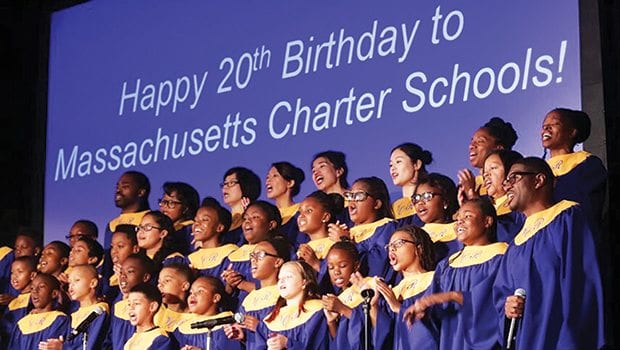20 years later, hard to evaluate charters
Extent of effect on education is unclear

Brittny Randolph, a teaching fellow at Boston Renaissance Charter School, was a kindergartener when the school opened in 1995. Her mother’s choice to enroll her and her siblings was “one of the best decisions she made for us,” said Randolph. “It definitely changed the trajectory of our lives.”
As Randolph and others now celebrate the twentieth anniversary of Massachusetts charter schools, they do so in a polarized climate. A law suit, legislation and ballot question that call for lifting the cap on new charter schools are meeting with stiff resistance from elected officials and district school supporters.
Charters were established in Massachusetts in 1995 as a way to foster innovation in the public school system. Legislators envisioned charters working collaboratively with school districts to pioneer and implement educational best practices. By many accounts, the fruits of charter schools’ innovation — and the academic achievements of charters in general — are unclear.
Charter independence
Charters operate as independent schools. Cut free from larger bureaucracy and negotiations, they are able to implement ideas relatively quickly. The operating assumption is that if any tested methods generate academic improvements, district schools will have evidence to support undertaking a lengthy implementation process to adopt those charter innovations.
Paul Hays, Chief Academic Officer of City on a Hill Charter School, said that his school’s autonomy has enabled more efficient curricular redesign to prepare for PARCC testing and a school schedule more amenable to weekly teacher planning.
“I talked to fellow administrators at district level — they’re trying to do same things we’re doing, but it takes such a long time. There are so many hoops to jump through,” said Hays.
Sharing innovation
Boston’s first charters were City on a Hill, Boston Renaissance Charter School and Neighborhood House Charter School. Representatives of all three say their schools spark diffusion of ideas or provide assistance to other schools.
Today, City on a Hill partners with Simmons College to train and certify teachers for working in urban public schools — district or charter — throughout the city.
“We train teachers who go out and teach in other public charter and public district schools with the aim of them staying in urban public education,” Hays said.
Administrators at Boston Renaissance School noticed that students with poor vision frequently went without glasses for months. Seeking to facilitate the process of getting glasses, they brought in a vision center, allowing students to get them on-site, said Franklin Shearer, director of Communications and Development at BCRS.
“It’s something other schools have taken note of,” he said, including members of BPS who were invited to visit.
Through a recently launched School Consulting Initiative, NHCS assists schools such as Mildred Avenue K-8 in working to turnaround their ranking and improve teaching and student performance. Kate Scott, executive director of NHCS, said in 2010 school representatives shared their methods with Harbor Pilot Middle School and helped Harbor faculty and staff reexamine the school’s processes. Subsequently, Harbor rose from Level 4 to Level 3.
NHCS actively pursues collaboration via its director of Curriculum and Instruction, whose responsibilities include sharing best practices and developing partnership with BPS.
“Charters have helped us think about longer school days and different models of education,” said city Councilor Tito Jackson.
Collaboration starts to grow
From the start, charters have worked with district schools on an individual level, said Marc Kenen, founder of the Massachusetts Charter Public School Association.
But these collaborations may not have been accessible or on the radar of all schools.
Ross Wilson, managing partner of Innovation for BPS, said that before the Boston Compact, he was unaware of any formal mechanism for collaboration. Wilson previously was a school principal. He said that at that time, in order to learn about charter’s work, he applied to join an informal network of charter and district school leaders, run not by BPS or charters, but by a nonprofit.
Though networks sprung up between teachers and principals, a formal system for facilitating collaboration was missing.
“Part of what we need to do is build infrastructure for that kind of exchange,” said Rahn Dorsey, city Chief of Education. “That’s been what’s lacking historically. That’s why you find isolated instances of collaboration.”
Boston Compact
By many accounts, the Boston Compact has been a major driver of collaboration between charters and districts. It was established in 2011 by Kevin Andrews, founding headmaster of NHCS, and Carol Johnson, former BPS superintendent.
Under the Compact, schools from different sectors might share insights and information about current or proposed programs or partner to explore an issue together, said Rachel Weinstein, Chief Collaboration Officer for the Compact. In one instance, she said, representatives from Catholic, district and charter schools came together to determine if using physical objects to demonstrate algebra problems helped improve special education students’ math performance. Participants shared school outcomes and concluded that this method helped close the achievement gap.
Learning goes both ways, with districts and charters frequently adopting ideas from each other, said Dorsey.
“It’s a two-way relationship,” he said.
Kenen said that charters have turned to districts for ideas on how to best serve students with higher needs.
“District schools are helpful as charters are learning to expand the services and range of students they’re able to provide service to. [Districts] help charters keep the hardest served kids,” he said.
Meanwhile, he said districts still gain from charter’s methods.
“Massachusetts charter schools are great at developing a one-on-one tutoring program, which district schools have looked pretty closely at,” Kenen said.
Falling short in the state
Boston’s growing collaboration has not necessarily been replicated across the state. Paul Andrews, director of Professional Development and Government Services for the Massachusetts Association of School Superintendents, said that in most of Massachusetts, charters and districts are not collaborating, meaning the intended purpose of the charter system is not being realized.
“[Information sharing] is not happening for the most part,” he said. “The original intent of [charters] was to see best practices and try to develop a coordination process. But it’s just not transpired.”
A December 2014 review of the Department of Elementary and Secondary Education by State Auditor Suzanne Bump found no solid evidence of collaboration. Her audit report said that DESE so poorly documented the charter schools’ innovations and efforts to spread and reproduce them that it is was impossible to tell if the charter schools fulfilled their purpose. Bump also found that DESE’s information on charter school waitlists was inaccurate and data accuracy was not verified.
“The extent to which the charter school system has provided a successful mechanism for developing and disseminating replicable innovation models is not determinable,” the audit states.
Funding complications
The state’s education funding system pits district and charters against each other for budgets, skewing conversations about charters’ impact.
Andrews said district schools also may have limited ability to adopt some of charter schools’ innovations. For instance, while charters have demonstrated the benefit of extended school days and years, lack of funding may prevent some districts from implementing this.
“There’s no question time spent learning is critical. In perfect world, one would try to give expanded learning time the same way in the public school sector. That requires funding, which is just not there,” he said.
Innovations aside, money can also go a long way toward improving district schools.
“Orchard Gardens went from a Level 4 to level 1 school with additional funding and support from the top,” said Councilor Jackson. “When they took funding away, that dropped. Resources being taken away are actually having an effect on public schools.”
“There should be additional collaboration,” he said, “but that the collaboration should not be a collaboration that is about taking over the public school system or putting it out of business.”
Dorsey said that the system under which per-pupil funding follows students from district schools to charters is not the case in most of the U.S.
“The state funding charters and districts out of the same pool is almost unique to Massachusetts,” he commented.
While work remains to be done to ensure all students receive the resources they need, Dorsey said this is a separate issue from the value of charters’ ideas and should not disrupt the mutually beneficial collaboration between school sectors.
“We have to work on more equity solutions, but that should not short-circuit creating mutual growth and mutual accountability to provide high quality instruction for every student,” he said.






